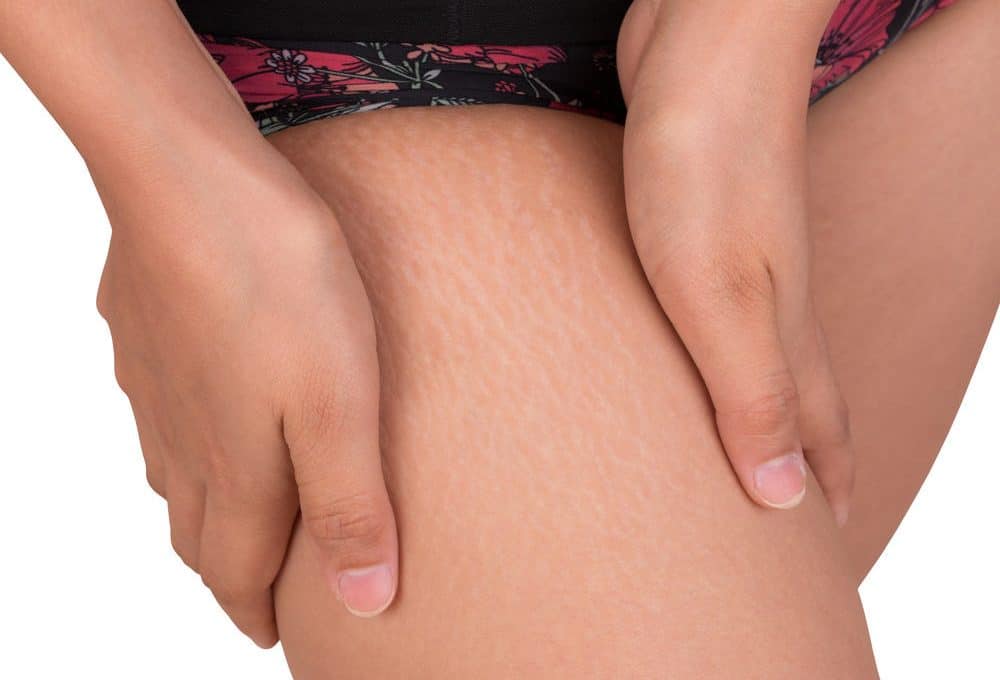Any rapid changes occurring in the body can cause stretch marks to form. While these marks do not pose any threat or physical danger, they might make some people feel conscious or anxious. Stretch marks usually crop up during pregnancy, puberty, and weight loss or weight gain episodes.
When your body undergoes any rapid physical changes, white, pink or even jagged purple marks can start appearing. Human skin possesses a certain degree of elasticity. However, if it is stretched beyond its capacity, collagen (protein responsible for holding up interconnected tissues) production cycle is interrupted and as a result, stretch marks form.
Getting Rid Of Stretch Marks
As we specified before, stretch marks won’t actually harm you in any way. However, for people with cosmetic concerns related to stretch marks, any method that reduces or gets rid of stretch marks is a boon. There are a few home remedies that are known to effectively get rid of and reduce the instances of stretch marks. Synthetic drugs that reduce stretch marks exist as well. These over the counter drugs tend to be expensive and demand a longer period to show effect.
One of the most commonly known remedies for stretch marks is vinegar. Apart from helping with these marks, vinegar is also useful in the treatment of infections, regulating glucose levels of the blood and maintaining low cholesterol levels in the body. When applied topically, vinegar is effective as an anti-stretch mark remedy.

Using Apple Cider Vinegar to Remove Stretch Marks
Apple Cider Vinegar is considered to be comparatively more useful than other vinegar variants. The acetic acid in vinegar supposedly helps exfoliate the upper layers of your skin for a refined smoothness and evened-out skin tone. It is believed that apple cider vinegar might also help in reducing cellulite. Cell regeneration is promoted through regular topical application. Micro elements and other vitamins that make up apple cider vinegar are beneficial in promoting healthier skin. People who use this product to get rid of their stretch marks have usually found positive results in about two weeks of regular use.
Now that we’ve spoken about the benefits of apple cider vinegar, let’s look at how you can use it to reduce stretch marks. One important thing to remember is to always take a hot shower, scrub your skin and use mild cleaning agents before using apple cider vinegar on your body.
Apple Cider Vinegar Spray
This is probably a very simple and mess-free way of using apple cider vinegar for stretch marks. To prepare the solution, simply pour a cup of the vinegar into a spray bottle. Yes, that’s all!
Spray this solution on your stretch marks every night before bed. Let it get absorbed into your skin overnight. The next morning, take a bath and thoroughly wash off the vinegar. After you dry yourself off, apply lotion or moisturizer to make up for the drying out of your skin. While vinegar does dry out your skin to a certain degree, it will not harm you as long as you moisturize after washing it off.
Apple Cider Vinegar Compress
Vinegar might be too harsh for people with sensitive skin. For such people, apple cider vinegar compress will work perfectly. To make the compress, first start by making a solution with 50 ml of apple cider vinegar and 150 ml of water. Using a soft, clean cloth dab the solution on to your stretch marks a few times. Anywhere between twelve to twenty repetitions are ideal. After doing this, take a cold shower, rinse off and moisturize your skin well.

Apple Cider Vinegar Wrap
Apple cider vinegar wraps are a great way to maximise the effect of the vinegar on your skin through full exposure. Not only do they help with stretch marks, but they also help vitamins and minerals in the vinegar penetrate deeper into your skin. To prepare the wrap, first rub vinegar onto your stretch marks. You could also use a spray to do so. Once this is done, wrap the still-wet skin with plastic wrap. Further cover this wrap in a blanket or warm cloth. After about an hour or two, take off the wrap, followed by a cold shower and liberal amounts of moisturizer.
Do not repeat this more than two to three times a week. People with sensitive skin or severely dry skin should stay away from this intense method.
Apple Cider Vinegar Bath
No matter what other way of applying apple cider vinegar you choose, you must incorporate apple cider vinegar baths into your regimen.
Obviously, we don’t mean you should bathe in pure apple cider vinegar. Not only is that dangerous, it is also incredibly unsustainable and expensive. Simply pour around 200-400 ml of vinegar into your bath water to get started. Depending on how sensitive your skin is and how prominent your marks are, adjust the quantity of the vinegar. You can also add a few drops of essential oils like lavender, orange, rose or pine into your bath.
Repeat this procedure no more than once or twice a week.
Selecting the Right Apple Cider Vinegar
As is the case with most things, natural is better. It is always better to pick natural, organic-certified vinegar as opposed to synthetic vinegar. The chemicals in synthetic vinegar might actually harm you than help you in any way. Here are some other tips to help you pick good-quality vinegar.
- The Shake Test: Natural vinegar foam disappears quickly owing to less precipitate in the product. To test, shake your bottle of vinegar and see if the foam disappears within seconds. If it takes longer, your vinegar might be synthetic.
- Packaging: Organic apple cider vinegar is photo-sensitive and will spoil quicker if exposed to light. Manufacturers who take efforts to package in amber coloured bottles are more likely to offer a higher-quality product.
- Price: Price, label, brand and composition are all important factors to consider while buying apple cider vinegar. While apple cider vinegar of higher purity and quality will be more expensive, it is well worth the investment.









